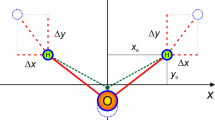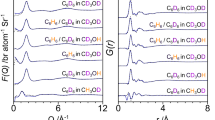Abstract
IN a recent paper (Roy. Soc. Proc., A, vol. 107, p. 684), I have shown that the optical anisotropy of the gaseous molecules of a number of di-atomic and tri-atomic compounds which is evidenced by the polarisation of the light scattered from them, can be explained by the mutual action of the electrical doublets induced in the different atoms of the molecule by the electric field of the incident radiation. Each atom was assumed to behave isotropically. Satisfactory agreement was obtained between the observed and calculated values of the depolarisation of the scattered light in the case of the molecules CO2, N2O and CS2.
This is a preview of subscription content, access via your institution
Access options
Subscribe to this journal
Receive 51 print issues and online access
$199.00 per year
only $3.90 per issue
Buy this article
- Purchase on Springer Link
- Instant access to full article PDF
Prices may be subject to local taxes which are calculated during checkout
Similar content being viewed by others
Author information
Authors and Affiliations
Rights and permissions
About this article
Cite this article
RAMANATHAN, K. The Structure of Benzene and Cyclohexane and their Optical Anisotropy. Nature 116, 279–280 (1925). https://doi.org/10.1038/116279b0
Published:
Issue Date:
DOI: https://doi.org/10.1038/116279b0
Comments
By submitting a comment you agree to abide by our Terms and Community Guidelines. If you find something abusive or that does not comply with our terms or guidelines please flag it as inappropriate.



